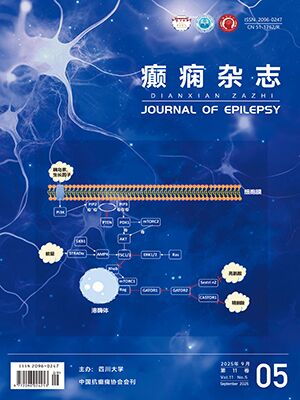| 1. |
Spencer S, Huh L. Outcomes of epilepsy surgery in adults and children. Lancet Neurol, 2008, 7(6): 525-537.
|
| 2. |
Spencer SS, Berg AT, Vickrey BG, et al. Predicting long-term seizure outcome after resective epilepsy surgery: the multicenter study. Neurology, 2005, 65(6): 912-918.
|
| 3. |
Kullmann DM. What's wrong with the amygdala in temporal lobe epilepsy. Brain, 2011, 134(Pt 10): 2800-2801.
|
| 4. |
Mitsueda-Ono T, Ikeda A, Inouchi M, et al. Amygdalar enlargement in patients with temporal lobe epilepsy. J Neurol Neurosurg Psychiatry, 2011, 82(6): 652-657.
|
| 5. |
Thom M, Mathern GW, Cross JH, et al. Mesial temporal lobe epilepsy: how do we improve surgical outcome. Ann Neurol, 2010, 68(4): 424-434.
|
| 6. |
Lambert MV, Brierley B, Al-Sarraj S, et al. Quantitative magnetic resonance imaging of the amygdala in temporal lobe epilepsy-clinico-pathological correlations (a pilot study). Epilepsy Res, 2003, 53(1-2): 39-46.
|
| 7. |
Cendes F, Andermann F, Gloor P, et al. MRI volumetric measurement of amygdala and hippocampus in temporal lobe epilepsy. Neurology, 1993, 43(4): 719-725.
|
| 8. |
Fischl B, Salat DH, Busa E, et al. Whole brain segmentation: automated labeling of neuroanatomical structures in the human brain. Neuron, 2002, 33(3): 341-355.
|
| 9. |
Morey RA, Petty CM, Xu Y, et al. A comparison of automated segmentation and manual tracing for quantifying hippocampal and amygdala volumes. Neuroimage, 2009, 45(3): 855-866.
|
| 10. |
Keller SS, Roberts N. Voxel-based morphometry of temporal lobe epilepsy: An introduction and review of the literature. Epilepsia, 2008, 49(5): 741-757.
|
| 11. |
Peng B, Wu L, Zhang L, et al. Volumetric changes in amygdala and entorhinal cortex and their relation to memory impairment in patients with medial temporal lobe epilepsy with visually normal MR imaging findings. Epilepsy Res, 2015, 114(3): 66-72.
|
| 12. |
Watson C, Andermann F, Gloor P, et al. Anatomic basis of amygdaloid and hippocampal volume measurement by magnetic resonance imaging. Neurology, 1992, 42(9): 1743-1750.
|
| 13. |
Wieser HG, Blume WT, Fish D, et al. ILAE Commission report. Proposal for a new classification of outcome with respect to epileptic seizures following epilepsy surgery. Epilepsia, 2001, 42(2): 282-286.
|
| 14. |
Beh SM, Cook MJ, D'Souza WJ. Isolated amygdala enlargement in temporal lobe epilepsy: a systematic review. Epilepsy Behav, 2016, 60(7): 33-41.
|
| 15. |
Lv RJ, Sun ZR, Cui T, et al. Temporal lobe epilepsy with amygdala enlargement: asubtype of temporal lobe epilepsy. BMC Neurol, 2014, 14(1): 194.
|
| 16. |
Kimura Y, Sato N, Saito Y, et al. Temporal lobe epilepsy with unilateral amygdala enlargement: morphometric MR analysis with clinical and pathological study. J Neuroimaging, 2015, 25(2): 175-183.
|
| 17. |
潘克梫, 陈楠, 王星, 等. 1 000名中国正常成人杏仁核体积高分辨力MRI测量.中国医学影像技术, 2010, 26(9): 1615-1619.
|
| 18. |
Gloor P, Olivier A, Quesney LF, et al. The role of the limbic system in experiential phenomena of temporal lobe epilepsy. Ann Neurol, 1982, 12(2): 129-144.
|
| 19. |
Wieshmann UC, Larkin D, Varma T, et al. Predictors of outcome after temporal lobectomy for refractory temporal lobe epilepsy. Acta Neurol Scand, 2008, 118(5): 306-312.
|
| 20. |
Mueller CA, Scorzin J, von Lehe M, et al. Seizure outcome 1 year after temporal lobe epilepsy: an analysis of MR volumetric and clinical parameters. Acta Neurochir (Wien), 2012, 154(8): 1327-1336.
|
| 21. |
Bonilha L, Jensen JH, Baker N, et al. The brain connectome as a personalized biomarker of seizure outcomes after temporal lobectomy. Neurology, 2015, 84(18): 1846-1853.
|




